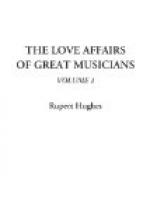But this tripartite angel died unborn, for in 1837 Chopin found himself deserted by her. So much we learn from Hoesick. And now we may return to Chopin’s immortal, if immoral, affair with George Sand.
George Sand will be remembered for the famous love affairs she has contributed to history long after her books have lost their last reader. It has been my habit in these papers to take the woman’s side, and even for George Sand there is much to be said in praise and in palliation. For her peculiar views of life her peculiar husband may be largely blamed, along with the peculiar ideals of the literary circle into which her unhappy married life drove her. That she showed good taste in either the management or the publication of her amorous entanglements one could hardly maintain, and yet the men in the case seem to have been at least as caddish as she was unwomanly. But it would take volumes to recount what volumes have already recounted, and bewilderment and contradiction would still be the chief result. Since so much of the story is familiar, I can be brief with it here.
George Sand’s relations with Chopin have been accepted in almost every conceivable manner. There have even been writers of such intelligence as Hadow who have maintained that she was entirely and solely a mother to him. Before a trust in humanity as bland as this, before a credulity that can deny itself to certain records and stretch itself to certain others, there is nothing to say except to express gratitude that in some hearts, at least, the belief in fairy stories is not left behind in the nursery.
On the other hand, it is not necessary to fly to the opposite extreme, and condemn the years that Chopin and Sand spent together as years devoid of very earnest sympathy, intellectual and artistic communion, and of mutual advantage. The relations were irregular, and were harrowed by the temperaments of each. Sand was masculine, energetic, restless, and by nature—for which she was surely not thoroughly to blame—a voluptuary. Chopin, while not the whining mooncalf some have painted him, was never of truly virile character. He was a man whose genius was as limited in scope as a diamond’s lustre, even while it had the brilliance, the firmness, and the solitariness of that jewel. And, most of all, he was that most pathetic of wretches, a sick man. He was drifting down the current of that stream which had carried off his gifted and adored sister when she was half his present age.
Sand was the former of the two to fall in love, and the earlier to fall out. After the first meeting, there was little delay in beginning that form of unchurched marriage so fashionable in the art world of that day. In 1838 they went to Majorca with Sand’s two children, a son and daughter, who had been born to her husband. The weather was atrocious, the accommodations primitive, and Chopin’s health wretched. He was beset by presentiments and fierce anxieties, and tormented by a hatred of the place and the clime. In June of the next year they went back to Nohant, her chateau. We owe to Sand herself the account of Chopin’s manner of life, his petulance, his self-inflicted torments, and the agonies of his art and his disease. We owe to her, also, the picture of her devotion both to his health and to his music.




